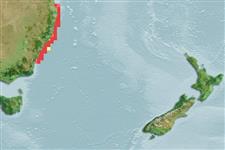分類 / Names
共通名の | 類義語 | Catalog of Fishes(部類, 種) | ITIS | CoL | WoRMS | Cloffa
Environment: milieu / climate zone / 深さの範囲 / distribution range
生態学
海 底生の; 深さの範囲 20 - 325 m (Ref. 114953). Temperate; 27°S - 36°S, 150°E - 154°E (Ref. 114953)
Western Pacific: endemic to eastern Australia.
Length at first maturity / サイズ / 重さ / 年齢
成熟: Lm 45.5, range 43 - 48 cm
Max length : 55.0 cm TL オス/雌雄の選別がない; (Ref. 114953)
Found on the continental shelf (Ref. 6871, 75154). Oviparous. Distinct pairing with embrace. Young may tend to follow large objects, such as their mother (Ref. 205). Eggs are oblong capsules with stiff pointed horns at the corners deposited in sandy or muddy flats (Ref. 205). Egg capsules measure 5.7 cm long and 3.2 cm wide (Ref. 41308). Males reaches maturity at 43-48 cm TL. Biology poorly known; probably have suffered population declines in recent years (Ref. 114953).
Life cycle and mating behavior
成熟 | 繁殖 | 放精 | 卵 | 生産力 | 幼生
Oviparous, paired eggs are laid. Embryos feed solely on yolk (Ref. 50449). Distinct pairing with embrace. Young may tend to follow large objects, such as their mother (Ref. 205).
McEachran, J.D. and K.A. Dunn, 1998. Phylogenetic analysis of skates, a morphologically conservative clade of elasmobranchs (Chondrichthyes: Rajidae). Copeia 1998(2):271-290. (Ref. 27314)
IUCNのレッドリストの状況は (Ref. 130435: Version 2025-1)
Human uses
水産業: bycatch
用具
特記事項
XMLをダウンロードして下さい
インターネットの情報源
Estimates based on models
Preferred temperature (参照
123201): 18.6 - 21.4, mean 20 °C (based on 8 cells).
Phylogenetic diversity index (参照
82804): PD
50 = 0.5010 [Uniqueness, from 0.5 = low to 2.0 = high].
Bayesian length-weight: a=0.00302 (0.00141 - 0.00645), b=3.24 (3.07 - 3.41), in cm total length, based on LWR estimates for this (Sub)family-body shape (Ref.
93245).
栄養段階 (参照
69278): 4.1 ±0.7 se; based on size and trophs of closest relatives
回復力 (参照
120179): 低い, 4.5年~14年の倍増期間の最小個体群 (Fec assumed to be <100).
Fishing Vulnerability (Ref.
59153): Moderate vulnerability (42 of 100).
🛈
